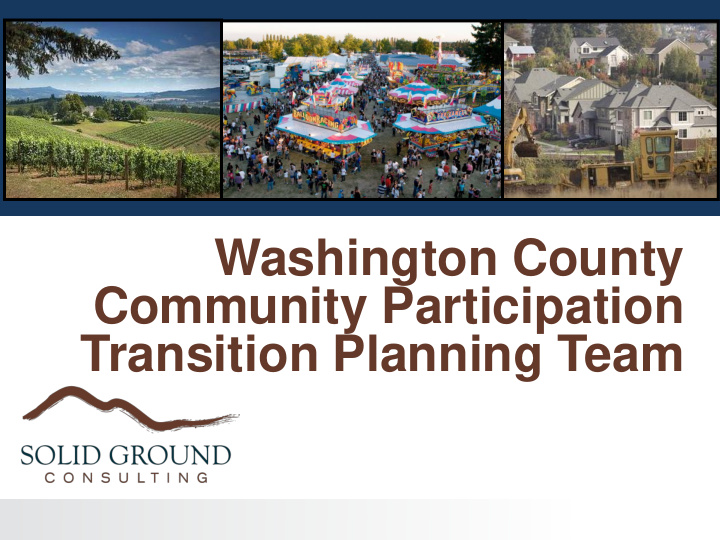



Washington County Community Participation Transition Planning Team
Team Members Andrée Tremoulet, PhD Center for Urban Studies Joe Hertzberg Holly Van Houten Meg Merrick, PhD Institute of Portland Metropolitan Studies Tina Dippert Graduate Intern JUNE 23, 2015 www.solidgroundconsulting.com
Promising Practices for Long-Term Community Participation Programs
TYPES OF COMMUNITY PARTICIPATION CPO Program Adapted from Leighninger, M. 2006
CONSTITUENCIES: WHAT IS A COMMUNITY? Communities of Communities of Geography Interest or Identity Adapted from Community for a Better New Orleans White Paper, January 2011, and City of New Orleans Neighborhood Engagement Office
PURPOSE OF PROGRAM Who Sets the Agenda? Jurisdiction- Initiated Public Community- Participation Agenda Community Initiated Problem- Agenda Solving
Insights from Stakeholders
A NATIONAL CHALLENGE Virtually all community engagement efforts struggle to attract broad participation, not just CPOs and not just Washington County. The Oregonian
CPO STRENGTHS AND WEAKNESSES Stakeholders shared insights into CPO system strengths and weaknesses. And they had suggestions for improvement. Doug Beghtel, The Oregonian
DIFFERENT CHALLENGES The Oregonian Incorporated, urban unincorporated, and rural areas pose very different challenges for community participation.
DIVERSITY Large and growing segments of the population are underrepresented, including communities of color, young people, and the business community.
TRUST Some stakeholders questioned how much the County truly values authentic community engagement.
EDUCATION AND TRAINING Education in how government works and training in effective leadership skills can expand and improve participation.
STAFFING There are strong arguments for both County staffing and independent staffing.
21 ST CENTURY TOOLS The universe of possibilities is ever-expanding. These tools do not replace face-to- face opportunities.
TRANSITION TEAM SCOPE Community Participation Broadly CPO System
PURPOSE Public Participation Community Problem- Solving
CONTENT All Community Public Issues Agency County Issues Issues Land Use and Transportation
CONSTITUENCIES Communities Communities of of Geography Interest
Contacts Joe Hertzberg Andrée Tremoulet, PhD 503-725-4075 Holly Van Houten atrem@pdx.edu 503-249-0000 joe@solidgroundconsulting.com Meg Merrick, PhD holly@solidgroundconsulting.com 503-725-8291 merrickm@pdx.edu JUNE 23, 2015 www.solidgroundconsulting.com
RULES OF THE ROAD • Strive for consensus, but recognize that the Commissioners asked for alternatives, so agreement on every option is not ultimately necessary • Speak up for your ideas AND listen boldly to the ideas of others • Check in with your peers in the community • Always be clear that you are speaking for yourself, not for the Transition Team
UNDERLYING PHILOSOPHY OF COMMUNITY PARTICIPATION 1. Active engagement is the engine of democracy. 2. Broad participation leads to better outcomes. 3. A welcoming and receptive attitude demonstrates that public officials understand and appreciate the benefits of community participation and take community input into account. 4. Trust develops when people feel that their government is transparent, cares about them, and listens to them. 5. Participation strengthens the sense of community. 6. Community education and awareness help people to participate effectively and articulate sound, informed opinions.
Recommend
More recommend